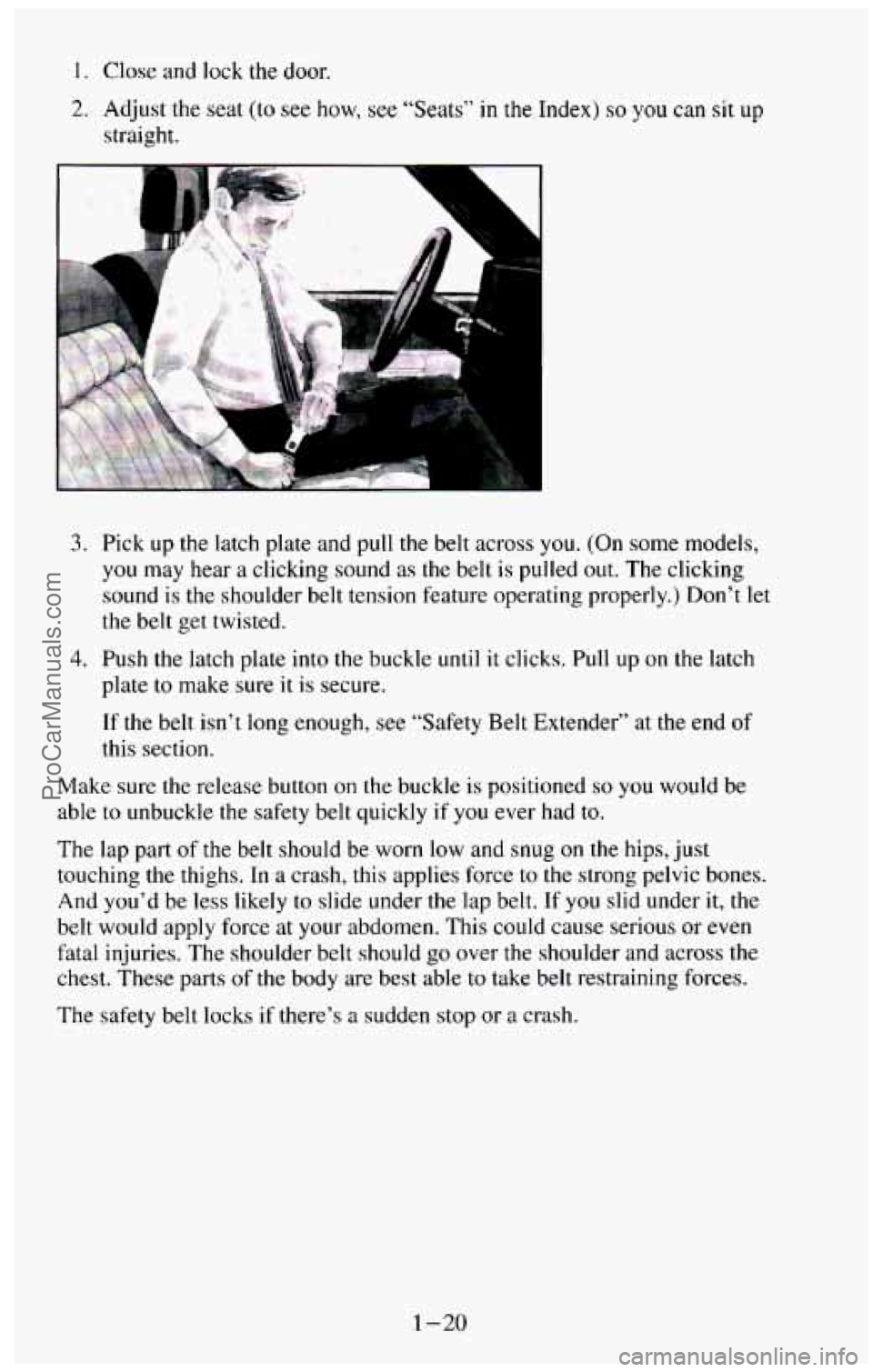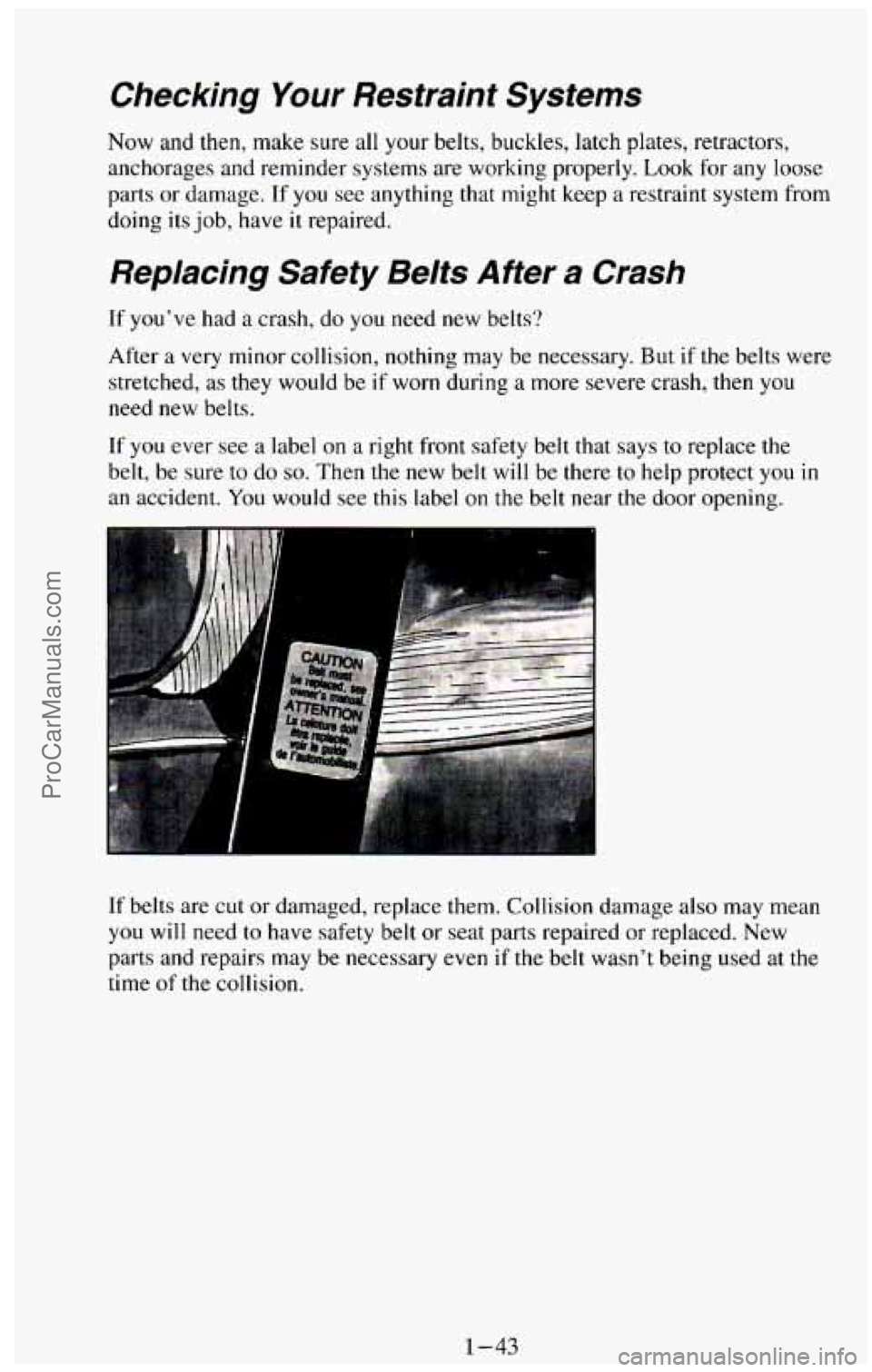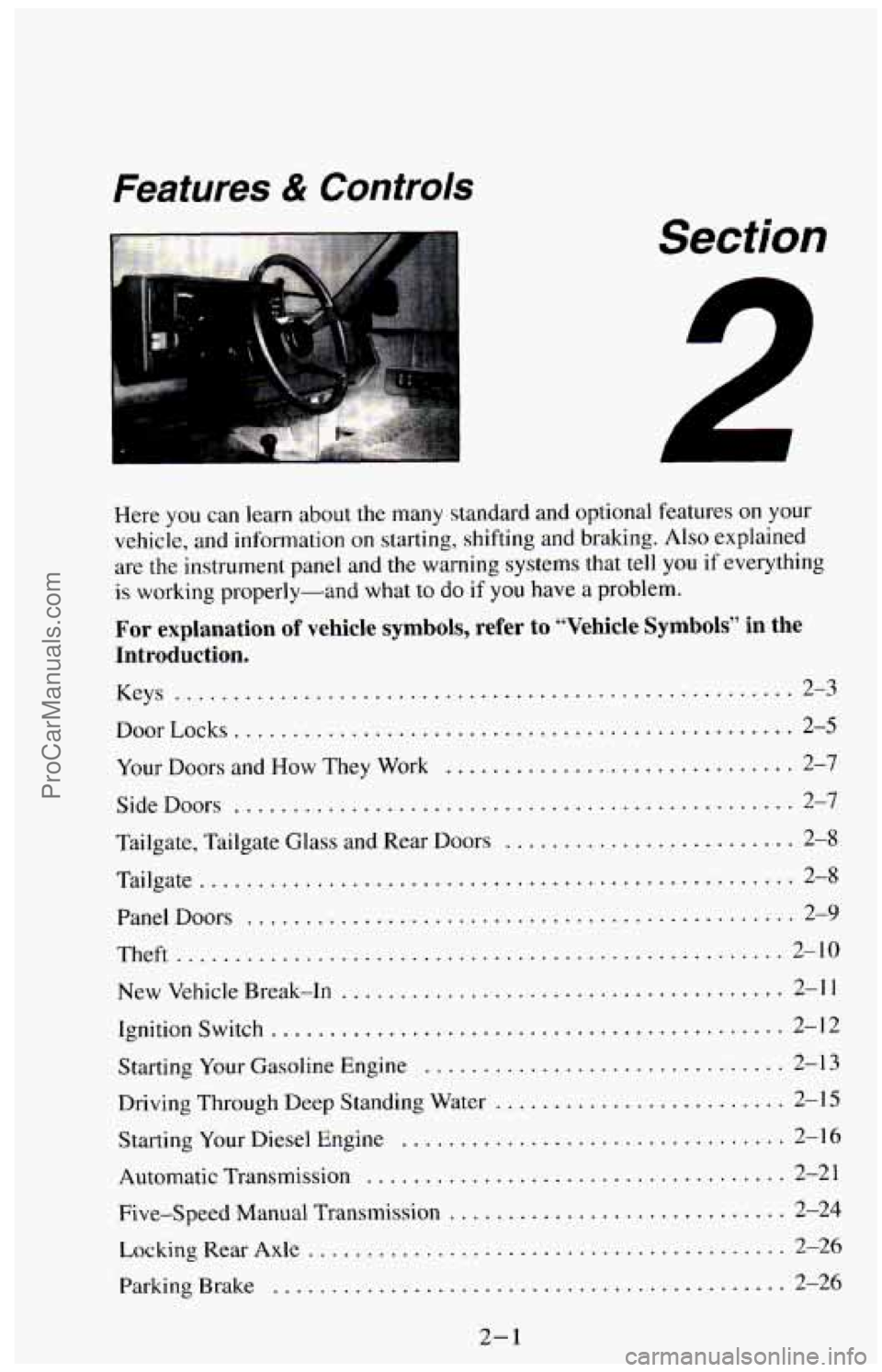Page 9 of 385
These symbols are important for you and your passengers whenever your
vehicle is driven:
IC I
Fasten Safety Door 1 ock/Unlock
Belts
These symbols have to do with your lights:
Master Lighting
Switch
Parking Lights
I
Turn Signal
Direction
Fog Lights
A
U
Hazard Warning
Flasher
1
Headlight
High Beam
Daytime
Running Lights
0
Off
Vlll ...
ProCarManuals.com
Page 22 of 385
To unlatch the safety
belt, press
in on the
inside of the buckle
cover
sleeve and pull
the latch plate out of
Then, hang the latch
plate end
of the belt
on the hook at the top
of the retractor cover,
out of the way.
To remove the seat, fully open the rear load doors and enter the back of the
vehicle.
Move
the seatback
release lever, at
the
right rear of the seat,
toward the center
of
the vehicle.
1-11
ProCarManuals.com
Page 31 of 385

1. Close and lock the door.
2. Adjust the seat (to see how, see “Seats” in the Index) so you can sit up
straight.
L 1
3. Pick up the latch plate and pull the belt across you. (On some models,
you may hear a clicking sound as the belt is pulled out. The clicking
sound is the shoulder belt tension feature operating properly.) Don’t
let
the belt get twisted.
4. Push the latch plate into the buckle until it clicks. Pull up on the latch
plate
to make sure it is secure.
If the belt isn’t long enough, see “Safety Belt Extender’’ at the end of
this section.
Make sure the release button on the buckle
is positioned so you would be
able
to unbuckle the safety belt quickly if you ever had to.
The lap part of the belt should be worn low and snug on the hips, just
touching the thighs.
In a crash, this applies force to the strong pelvic bones.
And you’d be less likely to slide under the lap belt. If
you slid under it, the
belt would apply force
at your abdomen. This could cause serious or even
fatal injuries. The shoulder belt should go over the shoulder and across the
chest.
These parts of the body are best able to take belt restraining forces.
The safety belt locks
if there’s a sudden stop or a crash.
1-20
ProCarManuals.com
Page 36 of 385
Q: What’s wrong with this?
I I 1 1
A: The belt is twisted across the body.
8
1 A CAUT1.ON:
To unlatch the belt,
just push the button on
the buckle. The
belt
should go back out of
I the way.
Before you close the door, be sure the belt is
out of the way. If you slam the
door on it, you can damage both the belt and your vehicle.
1-25 ProCarManuals.com
Page 54 of 385

Checking Your Restraint Systems
Now and then, make sure all your belts, buckles, latch plates, retractors,
anchorages and reminder systems are working properly. Look
for any loose
parts
or damage. If you see anything that might keep a restraint system from
doing its job, have it repaired.
Replacing Safety Belts After a Crash
If you’ve had a crash, do you need new belts?
After
a very minor collision, nothing may be necessary. But if the belts were
stretched,
as they would be if worn during a more severe crash, then you
need new belts.
If you ever see a label on a right front safety belt that says to replace the
belt, be sure to do
so. Then the new belt will be there to help protect you in
an accident. You would see this label on the belt near the door opening.
I
If belts are cut or damaged, replace them. Collision damage also may mean
you will need to have safety belt or seat parts repaired or replaced. New
parts and repairs may be necessary even
if the belt wasn’t being used at the
time
of the collision.
1-43
ProCarManuals.com
Page 56 of 385

Features & Controls
Section
L
r
1
Here you can learn about the many standard and optional features on your
vehicle. and information on starting. shifting and braking
. Also explained
are
the instrument panel and the warning systems that tell you if everything
is working properly-and what to do if you have a problem .
For explanation of vehicle symbols. refer to “Vehicle Symbols” in the
Introduction .
Keys ..................................................... 2-3
DoorLocks
................................................ 2-5
Your Doors and How They Work .... .................... 2-7 ..
................................................ Side Doors 2-7
Tailgate. Tailgate Glass and Rear
Doors ... ... ............... 2-8
Tailgate
........................... ...................... 2-8
PanelDoors
............................................... 2-9
Theft
.................................................... 2-10
New Vehicle Break-In
...................................... 2-11
Ignition Switch
.................................... . 2-12
Starting Your Gasoline Engine ......................... . 2-13
Driving Through Deep Standing Water
......................... 2-15
Starting Your Diesel Engine
................................. 2-16
Automatic Transmission .................................... 2-21
Five-Speed Manual Transmission
............................. 2-24
LockingRearAxle ......................................... 2-26
Parking Brake .................................... . . 2-26
2-1
ProCarManuals.com
Page 59 of 385
The oval-shaped key
is for the doors and all
other locks.
. :.
When a new vehicle is delivered, the dealer removes the plugs from the
keys, and gives them to the first owner.
Each
plug has a code on it that tells your dealer or a qualified locksmith
how to make extra keys. Keep the plugs in a safe place. If you lose your
keys,
you’ll be able to have new ones made easily using these plugs.
NOTICE:
Your vehicle has a number of new features that can help prevent
theft. But you can have a lot
of trouble getting into your vehicle
if you
ever lock your keys inside. You may even have to damage
your vehicle to get in.
So be sure you have extra keys.
2-4
ProCarManuals.com
Page 60 of 385
Door Locks
There are several ways to lock and unlock your vehicle: From the outside: Use
your door
key.
2-5
ProCarManuals.com